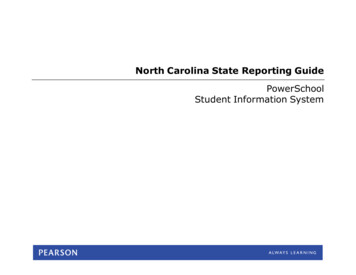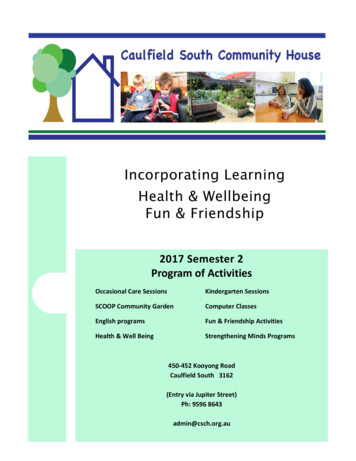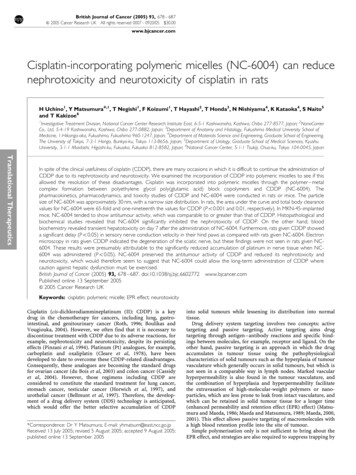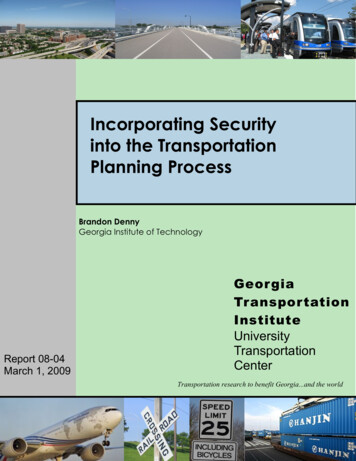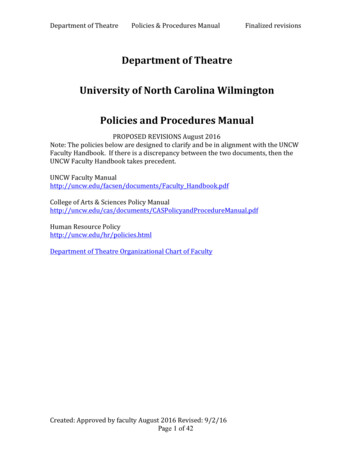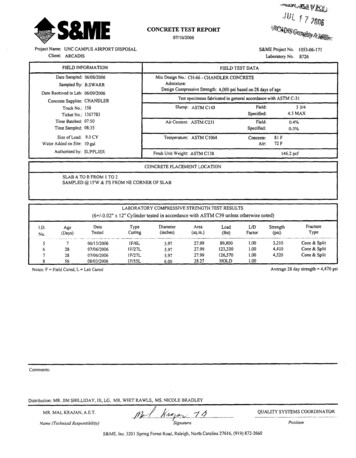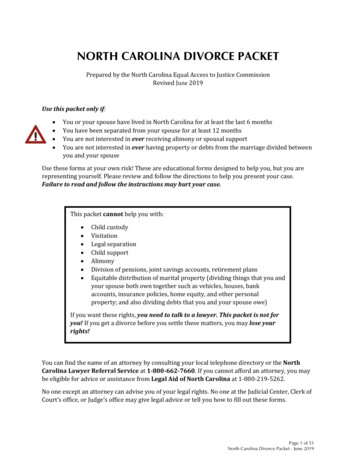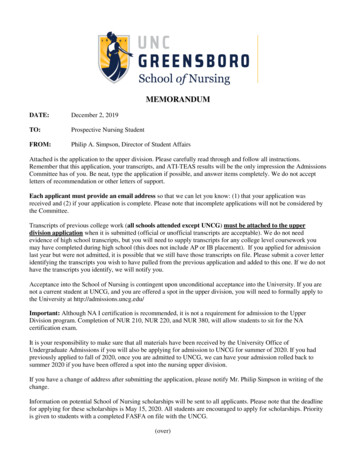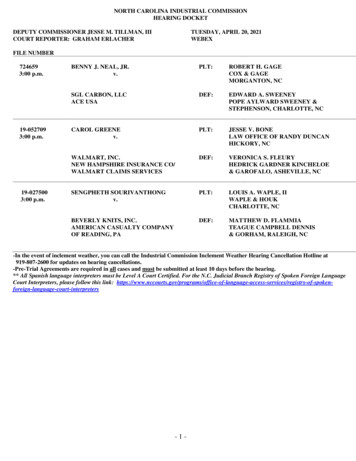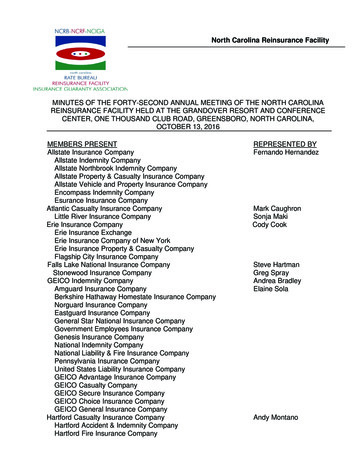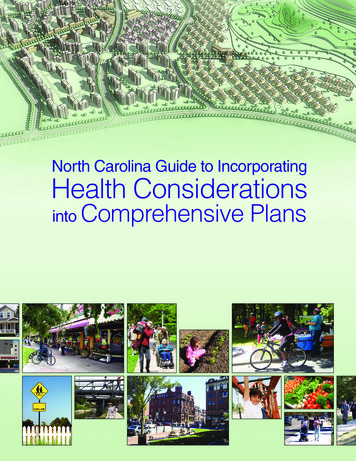
Transcription
North Carolina Guide to IncorporatingHealth Considerationsinto ComprehensivePlans
HOWTO USETHEGUIDETable of ContentsIntroduction . . . . . . . . . . . . . . . . . . . . . . . . . . . . . . . . . . . . . . . . . . . . . . . . . . . . . . . . . . . . . . . . . . . . . . . 3The North CarolinaGuide to IncorporatingHealth Considerationsinto ComprehensivePlans highlights theways that health canbe incorporated intocomprehensive plans.It is a compilationof strategies thatwere researchedand developed bypractitioners across thestate and is not intendedto serve any regulatoryfunction. It can beused by anyone who isinvolved in developingcomprehensive plansincluding city planners,health officials andcommunity residents.This Guide is notintended to contain anexhaustive list of allthe ways health canbe incorporated intocomprehensive plans;it is intended to serveas a guide to start theconversation abouthow health can beincorporated into theplanning process. Pleasenote that some goals/strategies may be morerelevant in a particularcommunity than others,depending on certainfactors (i.e., rural orurban community).Citation: North Carolina Divisionof Public Health. 2014. The NorthCarolina Guide to IncorporatingHealth Considerations IntoComprehensive Plans. NorthCarolina Department of Healthand Human Services, Raleigh, NC2Incorporating Health Considerations into Comprehensive Plans . . . . . . . . . . . . . . 5General Features . . . . . . . . . . . . . . . . . . . . . . . . . . . . . . . . . . . . . . . . . . . . . . . . . . . . . . . . . . . . . . . . 5Vision Statement and Guiding Principles . . . . . . . . . . . . . . . . . . . . . . . . . . . . . . . . . . . . . . 5Background Data . . . . . . . . . . . . . . . . . . . . . . . . . . . . . . . . . . . . . . . . . . . . . . . . . . . . . . . . . . . . . . . 6Goals and Strategies . . . . . . . . . . . . . . . . . . . . . . . . . . . . . . . . . . . . . . . . . . . . . . . . . . . . . . . . . . . . . 7Active Living . . . . . . . . . . . . . . . . . . . . . . . . . . . . . . . . . . . . . . . . . . . . . . . . . . . . . . . . . . . . . . . . . 7Transportation and Land Use . . . . . . . . . . . . . . . . . . . . . . . . . . . . . . . . . . . . . . . . . . . . 7Parks and Recreation . . . . . . . . . . . . . . . . . . . . . . . . . . . . . . . . . . . . . . . . . . . . . . . . . . . . . 8Healthy Foods . . . . . . . . . . . . . . . . . . . . . . . . . . . . . . . . . . . . . . . . . . . . . . . . . . . . . . . . . . . . . . . 9Emergency Preparedness . . . . . . . . . . . . . . . . . . . . . . . . . . . . . . . . . . . . . . . . . . . . . . . . . . . 10Environmental Exposures . . . . . . . . . . . . . . . . . . . . . . . . . . . . . . . . . . . . . . . . . . . . . . . . . . 10Health, Human, and Public Services . . . . . . . . . . . . . . . . . . . . . . . . . . . . . . . . . . . . . . . 12Social Cohesion . . . . . . . . . . . . . . . . . . . . . . . . . . . . . . . . . . . . . . . . . . . . . . . . . . . . . . . . . . . . 12Conclusion . . . . . . . . . . . . . . . . . . . . . . . . . . . . . . . . . . . . . . . . . . . . . . . . . . . . . . . . . . . . . . . . . . . . . . . . 13Glossary . . . . . . . . . . . . . . . . . . . . . . . . . . . . . . . . . . . . . . . . . . . . . . . . . . . . . . . . . . . . . . . . . . . . . . . . . . . 14Resources . . . . . . . . . . . . . . . . . . . . . . . . . . . . . . . . . . . . . . . . . . . . . . . . . . . . . . . . . . . . . . . . . . . . . . . . . 16Expert Reviewers . . . . . . . . . . . . . . . . . . . . . . . . . . . . . . . . . . . . . . . . . . . . . . . . . . . . . . . . . . . . . . . . . 17References . . . . . . . . . . . . . . . . . . . . . . . . . . . . . . . . . . . . . . . . . . . . . . . . . . . . . . . . . . . . . . . . . . . . . . . . 18METHODSThe North Carolina Guide to Incorporating Health Considerations intoComprehensive Plans (Guide) is based on the American Planning Association:Planning and Community Health Research Center’s (PCH) Evaluation Tool.PCH consulted existing model checklists or standards of health to create aninitial list of questions relating public health to planning for the PCH EvaluationTool. Additional questions were derived from current literature as well as theexpert opinion of PCH staff and their selected academic advisory committee.The PCH Evaluation Tool included 79 questions in seven categories: activeliving, emergency preparedness, environmental exposures, food and nutrition,health and human services, social cohesion and mental health and broad issues(including procedural issues, vision statement, guiding principles and backgrounddata).1 The PCH Evaluation Tool was used as the starting point; the goalsand strategies were tailored to North Carolina based on expert feedback. TheGuide was reviewed by local, state and national experts in July 2013. The editsfrom the expert review were incorporated, then the document was reviewed byprofessionals from across North Carolina in August 2013.North Carolina Guide to Incorporating Health Considerations into Comprehensive Plans
IntroductionNorth Carolina is participating in an increasingly competitive global economy.The state’s performance is linked to its ability to produce a highly educated,highly skilled, and healthy workforce as well as to create and maintain healthy,thriving communities. Healthy communities are places where business and industrywant to locate, entrepreneurs want to start their business ventures and people wantto live and visit. A healthy community environment encompasses aspects of humanhealth, disease and injury that are influenced by factors in the overall environment.2For example, health issues related to community design and land use include mentalhealth, injury, physical activity, respiratory health, air pollution, social capital, waterquality and accessibility.3 A healthy community begins with community design.Community design is the form and character of the built environment includingthe groupings of buildings, public spaces, neighborhoods, streetscapes and publicimprovements within a defined area.4Plans guide how a community is designed. Communities may create differenttypes of plans including land use plans, bicycle and pedestrian plans, park andrecreation plans and transportation plans. Comprehensive plans are the mostencompassing types of plans. A comprehensive plan creates a long-term visionfor the growth of a community. It is an official document adopted by a localgovernment (and can also address larger geographical areas, such as a city’sextraterritorial jurisdiction) that serves as a guide for making land-use changes,preparing capital improvement programs, and determining the rate, timing andlocation of future growth.5Health is a state ofcomplete physical, mentaland social well-being andnot merely the absence ofdisease or infirmity.6HEALTH IN ALL POLICIESHEALTH IMPACT ASSESSMENTS (HIA)Health in All Policies is a collaborative approach thatintegrates and articulates health considerations intopolicy making and programming across sectors, andat all levels, to improve the health of all communitiesand people. Health in All Policies requires publichealth practitioners to collaborate with other sectorsto define and achieve mutually beneficial goals.7For example, the North Carolina Department ofTransportation expanded its mission to integratepublic health considerations into its initiatives, plansand policies, as well as to explore the use of healthimpact assessments. This expanded emphasis onhealth comes from an observance of the connectionbetween the built environment and public healthoutcomes, such as chronic disease and obesity.8An HIA is a decision-making process used to identifyhow a project, policy, plan or program might influencehealth. It includes procedures, methods and tools tosystematically judge the potential, and sometimesunintended, effects of a proposed project, policy, planor program on the health of a population and thedistribution of those effects within the population. TheHIA also includes recommendations to enhance thehealth benefits of the project, policy, plan or programand to mitigate potential harms.9COVER PHOTO CREDITS: Grocery store, town center, women walking withstroller, men on walk path: www.pedbikeimages.org/Dan Burden; pedestrianson overpass: www.pedbikeimages.org/Julia Diana; family in community park:www.pedbikeimages.org/Laura Sandt; cylist in park: www.pedbikeimages.org/Tiffany RobinsonNorth Carolina Guide to Incorporating Health Considerations into Comprehensive Plans3
The comprehensive plan typically guides public policy regarding transportation,economic development, utilities, land use, recreation, housing and other elements asnecessary. Comprehensive plans provide a 20-30 year blueprint that influences thesocial, economic and environmental conditions of a community, all of which canhave long-term effects on health outcomes.Health considerations can be incorporated into comprehensive plans throughactive living, healthy foods, emergency preparedness, environmental exposures,health, human, and public services and social cohesion. Creating a North Carolinawith healthy people, environments and economics starts with healthy communitydesign. The North Carolina Guide to Incorporating Health Considerations intoComprehensive Plans outlines different health elements that can be incorporatedthroughout comprehensive plans.COMMUNITY ENGAGEMENTCommunity input can guide the development of comprehensive plans, as well as provide broadsupport of the plan and commitment to its implementation. Community input can be outlinedthrough a community engagement plan. The community engagement plan describes whoto involve in the plan development and how they can be involved.10 Community engagementcan include organized input from select people/representatives (e.g., steering committees,stakeholder interviews, focus groups, briefings); community-wide meetings (e.g., kick-offpublic information meetings, community forums, roundtable discussions, facilitated townmeetings, public hearings); communication media for educating and engaging the public(e.g., news releases and/or newsletters, email blasts, television, radio, social media) and formaldata collection (e.g., surveys,photographic journals).18 Engagingthe community in the planningprocess establishes networks tomobilize around collective actionsfor various issues/projects withintheir community, which fosterssocial capital within a community.114North Carolina Guide to Incorporating Health Considerations into Comprehensive Plans
Incorporating HealthConsiderations intoComprehensive PlansGeneral FeaturesThere are general features that can be addressed throughout the plan. These featuresinclude: Images to illustrate population and geographic data and/or how strategiesin the plan may impact different populations or geographies; Evidence of collaboration with the health department and/or othercommunity health stakeholder(s); Evidence of public involvement/public participation in the development ofthe plan; Identification of processes and procedures for evaluating/monitoring healthimpacts of strategies in the plan; Consideration of older adults, children, minorities, low-income residents,persons with limited English proficiency, people with physical and cognitivedisabilities, and other potentially vulnerable and underserved populationswhen planning for the future; and Maps to increase awareness of the location of potentially vulnerable andundeserved populations.Vision Statement and Guiding PrinciplesThe vision statement defines how a community envisions itself in the future. Theguiding principles are used to make decisions that ensure the plan is implementedto meet the community’s vision. The health of the people, the environment and theeconomy can be incorporated into the vision statement and the guiding principles.For example: Incorporate a broad goal to foster all residents’ health and well-being in thevision statement; Identify the built environment as a factor determining public health outcomesin the vision statement; and Indicate that the community values public health, social and health equity, orother health topics in the guiding principles.North Carolina Guide to Incorporating Health Considerations into Comprehensive Plans5
“ People of all abilities”refers to design andconstruction of facilitiesin compliance with, orexceeding, the Americanswith Disabilities Act (ADA),resulting in facilities whichare readily accessible toand usable by individualswith disabilities.Background DataBackground data provides information about the community’s needs. The data iscollected prior to the onset of the planning process and can be included in the planor in a separate technical document. Assessments can provide useful backgroundinformation for planning. The data gathered from these assessments of thecommunity can aid in the development of specific strategies. For example: A community health assessment; An assessment of bicycle and pedestrian infrastructure that needsimprovement to promote walking and biking by people of all abilities; An assessment of public health or motor vehicle crash data and the areasof high risk for potentially vulnerable road users (e.g., pedestrians, cyclists,children, older adults, persons with disabilities); An assessment of the current locations of public recreation/park space in thecommunity (e.g., X% of population lives within a 10 minute walk of a park); A community food assessment of the growing, processing, distributionand sale of foods as well as cultivating a healthy, green and affordable foodsystem; An assessment of the number of health and human service outlets availablefor populations in need; and An assessment of public safety/security measures which have beenidentified as important to promoting active lifestyles and healthy outdooractivities.Plan ImplementationPlan implementation can be addressed during the development process. Entire chapters or specificimplementation tasks within each chapter of the plan can address how the plan will be implemented.Considering implementation during the planning phase will help to identify achievable strategies thatrepresent the needs of the community. Plan strategies vary, including infrastructure projects, developmentregulations, studies, programs, agreements and committees. Local government is responsible for planimplementation. However, groups, organizations and residents (all stakeholders from the plan developmentphase) can play a critical role. Local government and community residents can work together to createthe timeline for conducting the specific action steps, identify the responsible party for handling the varioustasks and develop the implementation tools necessary to carry out the tasks (e.g., building codes,public facilities, infrastructure tools). Regular review of the plan will help to evaluate the success of itsimplementation efforts and ensure the plan remains up to date as the community evolves.126North Carolina Guide to Incorporating Health Considerations into Comprehensive Plans
Goals and StrategiesHealth considerations can be incorporated into various chapters of a comprehensiveplan, including active living; healthy foods; emergency preparedness; environmentalexposures; health, human, and public services and social cohesion. This part of theGuide includes different sections that may be included in a comprehensive plan toaddress health—making the safest and healthiest choices the easiest choices. Eachsection provides a brief overview of how health can be included and examples ofgoals and strategies to address health considerations.Active LivingActive living is a way of life that integrates physical activity into daily activities. Itgives residents the opportunity to be physically active by carrying out activities ofdaily living—such as walking to the grocery store, school or work, as well as playingin their neighborhood or at the local park. Active living requires places peoplecan be active, which are safe and convenient, and provide connectivity betweendestinations (e.g., home and work).GOALS Increase the number of people of all ages and abilities who walk and bike todaily activities or leisure-time physical activity; Create safe, accessible, usable and attractive places for leisure-time physicalactivity; Reduce car dependency and increase use of active transportation; and Prevent or reduce traffic injuries.STRATEGIESTransportation and Land Use Consider the transportation needs of potentially vulnerable andunderserved populations (e.g., older adults, children, persons withdisabilities, low-income residents, rural populations); Call for future development of, or refer to already established designstandards and guidelines related to pedestrian, bicycle and transit accessthat support active transport modes for people of all abilities; Establish a standard that promotes pedestrian activity (e.g., walkability) oruse pedestrian overlay zones to promote walking in commercial areas asnecessary for all users; Build, extend or develop an off-road trail (“greenway”) network for walkingand biking that can be used by people of all abilities; Incorporate complete streets design; Improve street connectivity to provide multiple routes and connectionswithin residential areas, and between residential neighborhoods anddestinations—such as schools and shops; Incorporate traffic calming measures (e.g., reorient street geometry, lowerspeed limits, raised crosswalks and intersections).North Carolina Guide to Incorporating Health Considerations into Comprehensive Plans7
www.pedbikeimages.org/Dan Burdenwww.pedbikeimages.org/Greg Griffin, AICP Incorporate bike racks onto buses and allow bikes on light rail, commuterand high-speed rails; Support increased access to public transportation, for example, establish/extend transit networks, provide more service on existing routes, exceedcurrent ADA Standards or otherwise encourage greater use of existingpublic transportation; Connect existing and proposed resources (e.g., network of trails, greenways,bike paths, bike lanes to parks); Support “Safe Routes to School” for children or other mechanisms thatsupport youth of all abilities walking and biking to school (e.g., locatingschools closer to residential areas, increasing sidewalks and connectivity) Encourage builders to build bicycle, pedestrian and ADA compliant accessin all new developments; Encourage builders of new homes to include Visitability Features i.e.,wheelchair accessibility from the home to the public sidewalks andtransportation; Encourage urban infill development rather than develop on the periphery,on undeveloped suburban land; Revisit local codes, ordinances and zoning to allow for more flexibility tosupport and encourage transportation-related walking and biking; Modify parking design, for example by reducing parking requireme
North Carolina Guide to Incorporating Health Considerations into Comprehensive Plans 3 Introduction N orth Carolina is participating in an increasingly competitive global economy . The state’s performan

